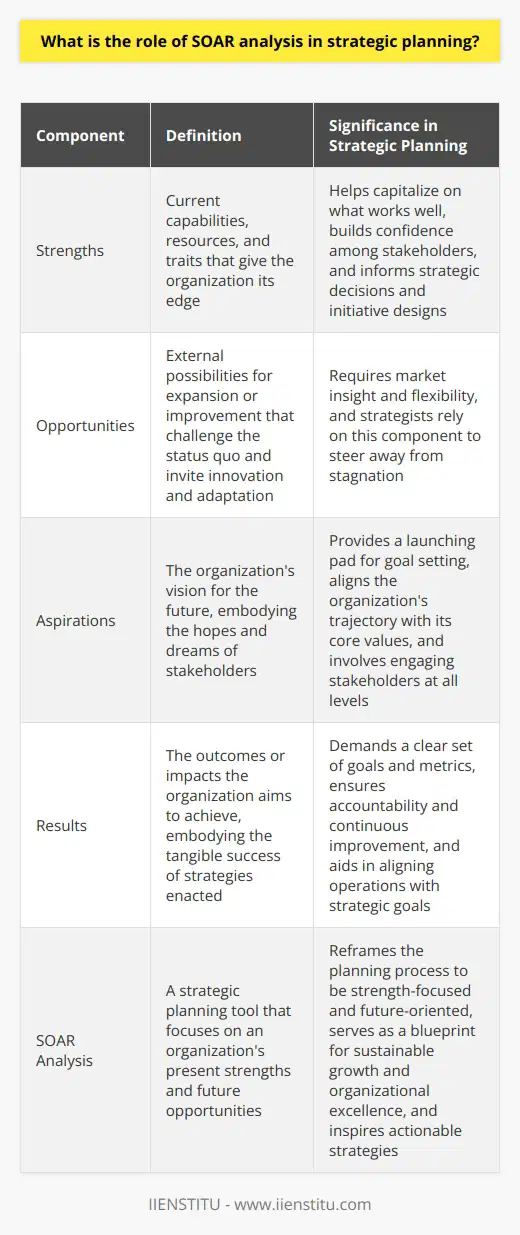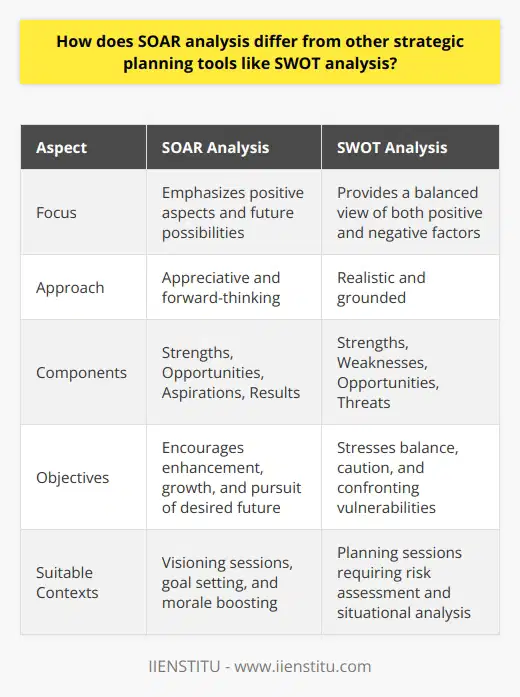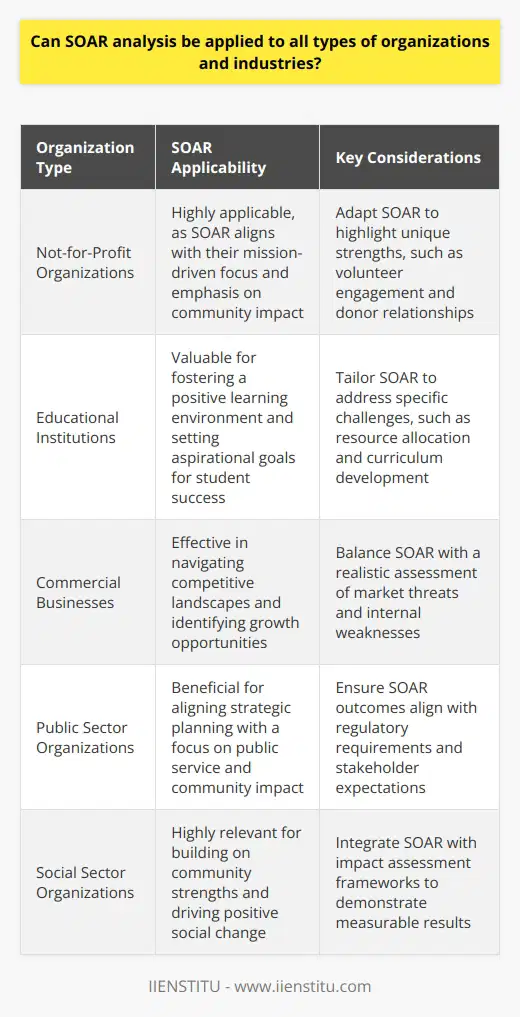
The business environment is perpetually evolving, and with it, the strategies and frameworks used for organizational development adapt. Emerging prominently in the field of strategic planning is SOAR Analysis, a tool designed to not only identify an organization's inherent positive attributes but also to leverage these to aspire and achieve.
Differentiating itself from the well-known SWOT (Strengths, Weaknesses, Opportunities, Threats) Analysis, SOAR focuses on a more positive framework that encourages constructive dialogue and future-oriented thinking. This unique approach makes it exceedingly relevant for contemporary business strategy and organizational growth, especially for entities aiming to infuse positivity into their strategic discourse.
🔊 Ready for an auditory reading experience? Just click the 'Play' button right below this text and immerse yourself in our captivating audio version. Ideal for those who prefer listening to stories, or for times when you're multitasking. Engage with our content effortlessly - one simple click is all it takes to transform your reading into listening!
SOAR is an acronym for Strengths, Opportunities, Aspirations, and Results – components that collectively contribute to a comprehensive and inspirational strategic planning process. Where SWOT Analysis emphasizes a defensive posture by identifying weaknesses and threats, SOAR encourages organizations to build upon existing strengths and envision opportunities in the marketplace. The aspirational aspect emphasizes what an organization wants to become, projecting an exciting future, while the results-driven focus aligns organizational efforts with measurable outcomes. It is this distinct orientation that makes SOAR Analysis a fundamentally unique approach within the realms of business development.
Understanding the nature and utility of SOAR Analysis is crucial for modern businesses and leaders. By incorporating it into strategic initiatives, companies are better equipped to navigate complexities and harness their full potential. It serves not only as a planning tool but also as an engine for fostering an empowering culture that can propel any business toward sustainable success. Those engaged in a problem solving course or an online mba course may find SOAR Analysis to be a transformative element of their curricula, blending theoretical knowledge with practical, positive strategy development.
The Pillars of SOAR Analysis
SOAR Analysis comprises four foundational components: Strengths, Opportunities, Aspirations, and Results. Each of these pillars plays a critical role in aiding businesses to chart a course that is both ambitious and achievable. By recognizing and building upon strengths, for instance, organizations can foster resilience and create a platform from which to explore future possibilities.
These elements, when combined, form a powerful method for enhancing business development. They prompt leaders to shift away from a deficiency-focused mindset and instead concentrate on potential and growth. The aspirational component of SOAR, in particular, is designed to stretch the imagination and ambition of an organization, setting sights on not just what is, but what could be. It's this future-oriented thinking that sets SOAR Analysis apart from traditional strategies.
The effectiveness of SOAR Analysis can be witnessed in various organizations that have embedded these pillars into their strategic planning rituals. For example, firms utilizing SOAR have reported higher levels of employee engagement, increased innovation, and an improved ability to capitalize on market opportunities. This is because SOAR not only prioritizes tangible results but also values the journey towards these outcomes, fostering a sense of purpose and direction throughout the organization.
Delving into Strengths
Understanding and leveraging organizational strengths is a cornerstone of SOAR Analysis. These are the competencies and positive attributes that give a company its competitive edge. To harness these strengths, methodologies such as stakeholder interviews, surveys, and workshops can be effective in revealing not only what an organization excels at but also what energizes its workforce and satisfies its clientele.
Real-life case studies demonstrate the crucial role that a thorough comprehension of strengths plays in strategic planning. Consider a technology firm that recognized its customer service as a central strength and decided to build new service offerings around this competency. The SOAR Analysis enabled them to align their strategies with their core advantages, resulting in robust business growth and heightened customer loyalty.
Identifying Opportunities
Opportunity identification within SOAR differs significantly from other strategic frameworks because it focuses on optimistic potential rather than simply external conditions. Organizations are encouraged to look beyond their immediate market and consider broader societal and technological trends that can be harnessed for expansion and growth.
Effective assessment of opportunities requires a forward-thinking and outward-looking mindset that is receptive to innovation and willing to embrace risk. For instance, an industrial manufacturer might use SOAR Analysis to pivot towards sustainable production methods, recognizing these as opportunities for differentiation and leadership in a rapidly evolving sector.
Aspirations: The Heart of Progress
Aspirations within the SOAR framework act as the driving force behind an organization's strategic trajectory. They embody the collective vision and ambition of a company and serve as the motivational catalyst for progress. Careful articulation of aspirations aligns the goals of the business with the drive of its employees and the expectations of its stakeholders.
Illustrating the impact of well-defined aspirations are stories of businesses that, against considerable odds, achieved extraordinary feats by setting their sights on ambitious goals. This empowers organizations to transcend their current operations, fostering an environment of innovation and determined pursuit of a shared mission.
Results: Measuring Success
The results component in SOAR is about establishing metrics that are not only quantifiable but also resonate deeply with the organization's strategic intentions. Key performance indicators (KPIs) must be thoughtfully devised to reflect the unique aspirations and strengths of the company.
Striking a balance between short-term achievements and long-term success is vital, as is adjusting strategies based on results to ensure continuous improvement. For example, a retail chain implementing SOAR Analysis may focus its KPIs on customer satisfaction and brand loyalty, which, while impacting immediate sales, also contribute to enduring brand strength.
Implementing SOAR Analysis in Strategic Planning
Implementing SOAR in strategic planning necessitates a disciplined and systematic approach. Beginning with an appreciative inquiry into the organization's strengths sets a positive tone. This could involve workshops or team meetings that help in articulating the collective competencies and competitive advantages of the business.
Integrating SOAR within existing planning processes can be streamlined by identifying overlaps with current strategic priorities and objectives. However, leaders should be mindful of potential pitfalls, such as resistance to change or misalignment between the SOAR framework and the company's operational reality. Overcoming such challenges requires transparent communication and a commitment to the SOAR principles.
Maintaining Momentum with SOAR
Post-implementation, maintaining momentum is about ensuring that the SOAR framework becomes a sustained part of strategic conversations and decision-making. Revisiting the analysis periodically helps to keep the strategy current with changes in the internal and external environment.
As the company evolves, the SOAR framework should be recalibrated to accurately reflect the organization's development. Continual learning from each stage of implementation helps to refine future planning and reinforces a strategic mindset that is adaptable and resilient in the face of change.
Building a SOAR-Oriented Culture
Cultivating a culture that embodies SOAR principles is necessary for the framework's long-term integration and success. Encouraging participation from all organization levels ensures that the cultural shift towards SOAR is inclusive and representative of the diversity within the company.
This can be achieved through leadership endorsement, recognition programs that reward alignment with the SOAR philosophy, and consistent strategic messaging that underscores the role of every employee in the company's aspirational journey. Success stories that epitomize this cultural shift not only serve as inspiration but also as a testament to the potential of a SOAR-implemented strategy.
In summary, SOAR Analysis offers a fresh perspective that aligns with the needs of an ever-changing business landscape. By focusing on strengths, recognizing opportunities, setting bold aspirations, and tracking results, organizations can embrace a more positive and proactive approach to their future.
The potential of SOAR to impact business development and strategic planning is significant. As companies strive to thrive in a dynamic world, a SOAR framework can anchor them with a vision that is both grounded and aspirational. Leaders who are willing to adopt this forward-thinking strategy will find themselves better equipped to navigate the complexities of organizational growth and change.
Frequently Asked Questions
What is the role of SOAR analysis in strategic planning?
Understanding SOAR Analysis in Strategic Planning
SOAR analysis stands for Strengths, Opportunities, Aspirations, and Results. It emerges as a strategic planning tool. Its focus lies in an organization's present strengths and future opportunities. Unlike traditional SWOT analysis, SOAR focuses on the positive. It helps organizations envision and enact a future that is both desirable and attainable.
Strengths in SOAR
Strengths represent an organization's current capabilities. They include resources and traits that give the organization its edge. Recognizing strengths helps capitalize on what works well. It also builds confidence among stakeholders. It informs strategic decisions and initiative designs in strategic planning.
Opportunities in SOAR
Opportunities point to external possibilities for expansion or improvement. They challenge the status quo. Opportunities invite innovation and adaptation. Recognizing them requires market insight and flexibility. Strategists rely on this component to steer away from stagnation.
Aspirations in SOAR
Aspirations illustrate an organization’s vision for the future. They embody the hopes and dreams of stakeholders. Aspirations provide a launching pad for goal setting. They align the organization's trajectory with its core values. Crafting aspirations involves engaging stakeholders at all levels.
Results in SOAR
Results are the outcomes or impacts the organization aims to achieve. They embody the tangible success of strategies enacted. Measuring results demands a clear set of goals and metrics. This ensures accountability and continuous improvement.
SOAR analysis operates as a unifying force in strategic planning. It encourages collective buy-in and positive outlooks. It shifts the focus from problem-centric to strength-based planning. SOAR streamlines the strategic process by consolidating efforts and resources. It enables organizations to leverage their assets effectively.
Strategists employ SOAR to facilitate strategic conversations. It offers a structure for dialogue and encourages inclusivity. Its simplicity makes it accessible across all organizational levels. By bridging the gap between the present and the future, SOAR aids in crafting actionable strategies.
Organizations gain a clear direction through SOAR analysis. It informs decision-making and prioritization. It aids in aligning operations with strategic goals. Teams become empowered through recognition of their strengths and potential. Opportunities for growth become more apparent.
To summarize, the role of SOAR analysis in strategic planning is integral. It reframes the planning process to be strength-focused and future-oriented. It serves as a blueprint for sustainable growth and organizational excellence. Through SOAR, strategies are not only formed—they are inspired.

How does SOAR analysis differ from other strategic planning tools like SWOT analysis?
SOAR Analysis Versus SWOT
Strategic planning serves as the foundation for organizational success. Two prevalent tools offer contrasting approaches: SOAR and SWOT. Each tool has distinct features and focal points. They cater to different objectives in the strategic planning process.
Understanding SOAR
SOAR stands for Strengths, Opportunities, Aspirations, and Results. SOAR analysis focuses on an organization’s current capabilities and future possibilities. It underscores positive aspects. The approach is appreciative. SOAR leads organizations to leverage their best qualities. It encourages forward thinking.
- Strengths: What the organization does well.
- Opportunities: External chances for growth.
- Aspirations: The organization's vision and ambitions.
- Results: Tangible outcomes the organization aims to achieve.
Understanding SWOT
In contrast, SWOT stands for Strengths, Weaknesses, Opportunities, and Threats. This analysis offers a balanced view. It considers both positive and negative factors. SWOT is practical and grounded. The tool helps organizations address their vulnerabilities. It prepares them for potential external challenges.
- Strengths: Positive attributes within an organization's control.
- Weaknesses: Internal shortcomings to improve upon.
- Opportunities: External conditions to capitalize on.
- Threats: External risks to navigate and mitigate.
Key Differences
SOAR and SWOT differ in perspective and application. SOAR fosters an appreciative inquiry. It drives organizations to envision and pursue their desired future. SWOT, however, promotes a realistic assessment. It reveals the full spectrum of an organization's internal and external environment.
SOAR emphasizes enhancement and growth. It encourages participants to dream and design. SWOT stresses balance and caution. It requires organizations to confront and offset weaknesses and threats.
SOAR builds on positive psychology. It thrives on collective dialogue and consensus-building. SWOT demands critical thinking. It engages teams in problem-solving and contingency planning.
SOAR draws from an organization’s best practices. It looks to replicate and expand on these. SWOT instructs to secure and protect an organization's position. It suggests strategies for improvement and defense.
Application Context
The choice between SOAR and SWOT depends on context. Organizations with a strong foundation may prefer SOAR. It can amplify their existing momentum. Groups facing uncertainty may opt for SWOT. This tool can provide a comprehensive situational analysis.
SOAR works well for visioning sessions and goal setting. It is effective where morale boost is necessary. SWOT suits planning sessions that require risk assessment. It's practical when confronting difficult competitive landscapes.
In sum, SOAR and SWOT serve strategic planning with unique advantages. Each leads to divergent pathways of organizational thought and action. Leaders must gauge their situation to select the most applicable tool. The goal remains consistent: to forge a strategic plan that propels the organization forward.

Can SOAR analysis be applied to all types of organizations and industries?
Understanding SOAR Analysis
SOAR stands for Strengths, Opportunities, Aspirations, Results. It is a strategic planning tool. It differs from traditional SWOT analysis. It focuses on the positive potential of an organization.
Applicability in Various Organizations
SOAR applies to diverse organizations. Consider not-for-profits, educational institutions, and businesses. Each has unique dynamics. SOAR can adapt to each one.
Strengths: This component examines organizational capabilities. It looks at what an organization does best. All types of organizations have strengths. They can harness these for improvement.
Opportunities: Opportunities are external chances for growth. They arise in any industry's environment. SOAR helps organizations spot and seize these chances.
Aspirations: This area involves an organization's vision. All organizations benefit from clear aspirations. They guide long-term objectives.
Results: The focus here is on measurable outcomes. Setting specific results is vital across sectors. Each entity sets distinct benchmarks for success.
Flexibility Across Industries
SOAR's adaptability across industries is noteworthy. It adjusts to the commercial sector's competitive climate. It caters to the public sector's focus on service. It even matches the social sector's community-oriented mission.
Fostering a Positive Outlook
SOAR instills a positive organizational outlook. It encourages building on what works well. This resonates with all organizations. They all aim for growth and excellence.
Limitations and Considerations
No single tool fits every context perfectly. SOAR may not highlight an organization's weaknesses adequately. Critics argue this may impede addressing challenges.
Final Analysis
In conclusion, SOAR analysis boasts wide applicability. It supports strategic development across diverse settings. All organizations can tailor SOAR to their needs. They can utilize it to propel themselves forward. SOAR drives positive change. It does so for businesses, non-profits, educational institutions, and beyond.



